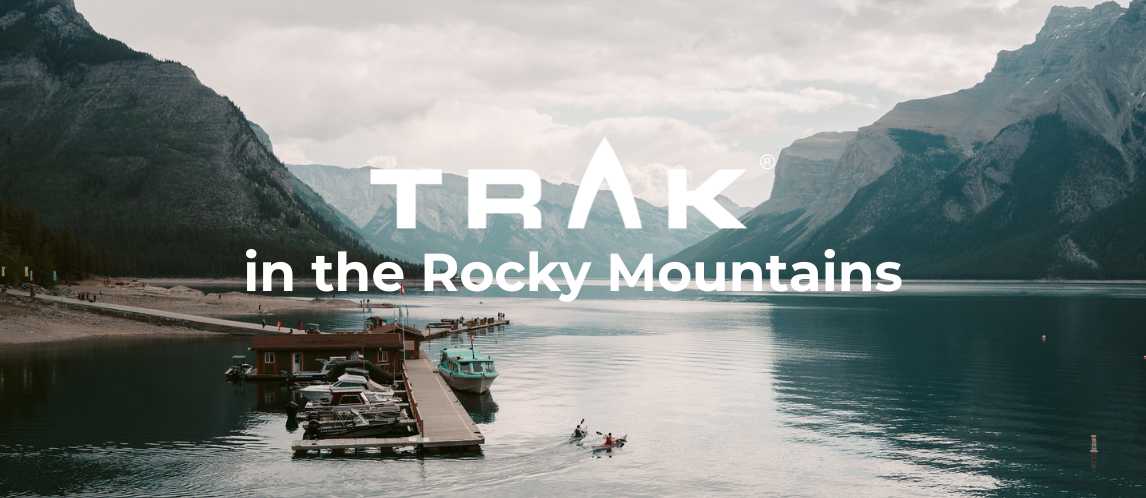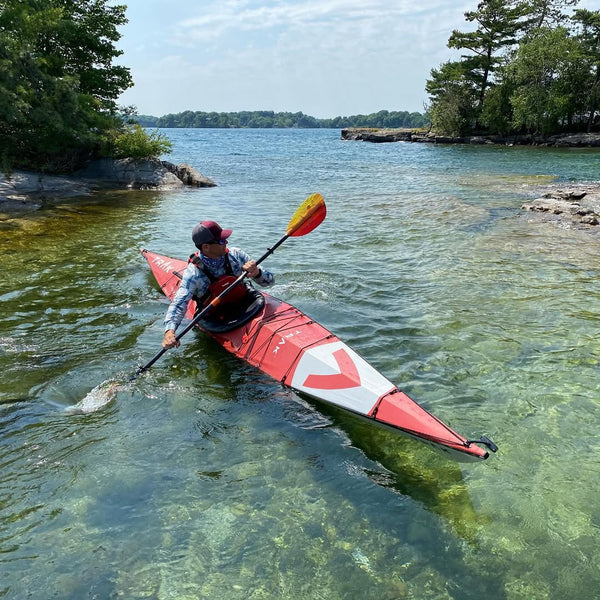Author: Cody Shimizu
Canmore, Canada
July 8, 2025

Lately, like many people, I’ve noticed how much time I spend scrolling through social media. It feels like everyone is off on massive bucket-list adventures — kayaking in faraway places, setting out on multi-week expeditions. I can’t help but feel a little jealous. With life stuck on repeat — work, home, sleep, repeat — I knew I needed a change.

This weekend, some pals and I decided to do something about it. Not a huge trip, no flights, no weeks off work. Just something simple: an overnight paddle on Lake Minnewanka in Banff National Park. I’m lucky to have such an incredible place in my backyard, and even if you’re not local, it’s only about an hour and a half from Calgary.
About Lake Minnewanka
Lake Minnewanka is a massive glacial lake stretching about 21 km, making it the largest body of water in Banff National Park. With its length and steep mountains rising straight from the shoreline, it feels like paddling through a fjord.
But don’t underestimate it, the shape of the lake acts like a funnel, and high winds often whip through in the afternoon, creating challenging conditions. If you’re heading out, make sure you’re prepared with the right safety gear and plan your paddling for mornings when the water is calm.
Fun Fact: The original townsite of Minnewanka Landing sits underwater. In the 1940s, the lake was dammed for hydroelectricity and the town was submerged. On calm days, scuba divers still explore the remains.

Camping on the Lake
One of the best things about Lake Minnewanka is how well it’s set up for overnight trips. Parks Canada maintains a handful of designated backcountry campsites along the shoreline, accessible only by boat. There are six sites in total, and my friends and I camped at LM11 (11 km from the launch), about halfway down the lake.
Reservations are required through Parks Canada, and don’t forget your Parks Pass. Campsites are equipped with bear bins, which makes food storage easy.

My Overnight Trip
We packed light — kayak, tent, food, the basics — and loaded everything into my small car. After dropping gear by the water and parking, it didn’t take long to pack the boats and launch. Within five minutes of paddling, the buzz of tourists, tour boats, and buses had disappeared.
It felt amazing to be back on the water. The paddle strokes through crystal-clear water, ripples trailing off the bow, and the sheer size of the surrounding mountains kept my head on a swivel the entire way. The trip to the campsite wasn’t long or difficult, but it was exactly what I needed: a break from the routine and, best of all, no cell service. No buzzing phone, no endless scrolling — just quiet and space to take in the scenery.

That evening, my friends and I watched the sun dip behind the peaks and went to sleep early, ready to catch calm morning waters for the return. I woke to an incredible sunrise: bright red alpine glow lighting up the mountains, and the warm morning sun on my back as I paddled home.
It wasn’t the grandest adventure. I didn’t hop on a plane or travel halfway around the world. But it was enough. Just a weekend away, and I came back feeling reset and recharged. Sometimes, the best adventures are the ones you can actually fit in.

If You Go: Lake Minnewanka Overnight
-
Drive time: About 1.5 hours from Calgary, 15 minutes from Banff townsite.
-
Reservations: Backcountry campsites must be booked through Parks Canada. Campsite names (LM8, LM9, LM11, etc.) indicate the distance in kilometers from the launch.
-
Paddle time: Depends on the campsite you choose, ones as close as ~8km to as far as ~21km
Safety (Required by Transport Canada for small vessels under 6m)
-
One properly sized, Canadian-approved PFD or lifejacket per person (must be worn)
-
One buoyant heaving line (minimum 15 m)
-
One manual sound-signaling device (e.g. whistle)
-
One bailer OR manual bilge pump
-
One watertight flashlight (if paddling after sunset or before sunrise)
-
Navigation lights (if on the water at night/low visibility)
Other important considerations:
-
Strong afternoon winds are common — plan to paddle early in the day.
-
Cold glacial water means hypothermia is a real risk: always dress for the water, not the air (neoprene or dry suit recommended in shoulder seasons).
-
Always check the weather forecast before launching, and be ready to wait out conditions.
Food Storage
-
Bear bins are provided at designated campsites, but always follow safe food-handling practices.
What to Pack
-
Kayak, paddle, PFD, safety gear (above)
-
Tent, sleeping bag, sleeping pad
-
Food and cooking supplies
-
Warm, waterproof layers (weather can shift quickly)
-
Parks Pass + campsite permit
-
Map, compass or GPS (don’t rely on cell service)
-
Fun games!
Connectivity
-
Cell service is spotty to non-existent — enjoy the disconnect.





Share: